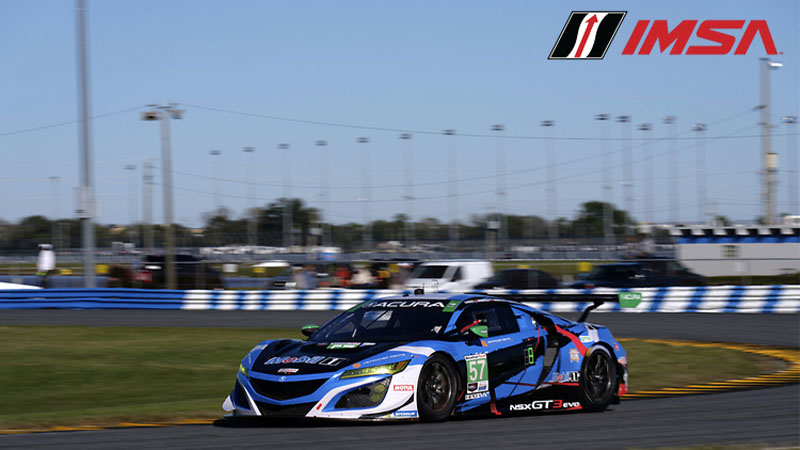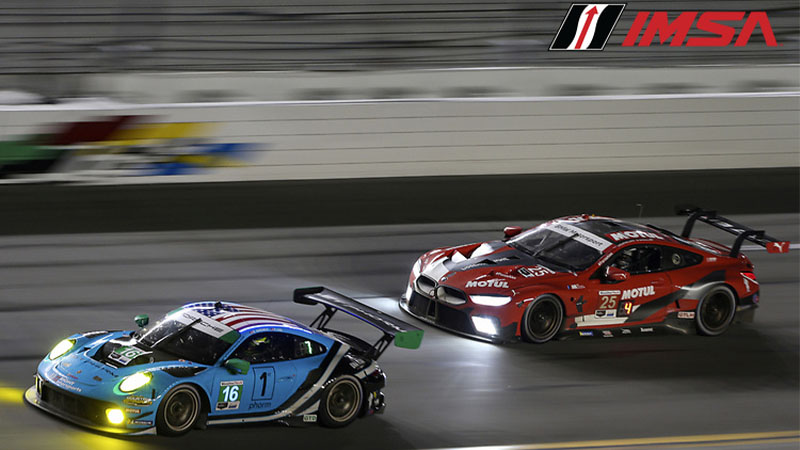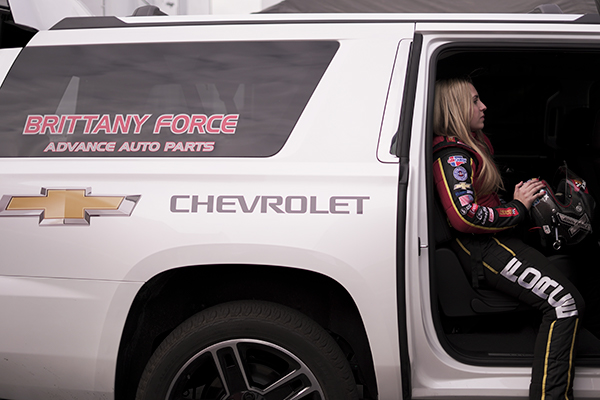There is an assumption that sportscar racing is all about endurance events that last up to 24 hours and are simply races of attrition for drivers and machines. In reality, it is so much more than that.
That's the idea that has been romanticized by the famous Le Mans 24 Hours event in France and has filtered down elsewhere around the globe. The reality is that endurance racing comes in many shapes and sizes so if you're looking to expand your motorsport-viewing horizons, the International Motor Sports Association, or IMSA, is a great place to start.
IMSA's primary sportscar category – the WeatherTech SportsCar Championship – takes a lot of pride in its own famed event – the Daytona 24 Hours – which has been a staple of American sportscars for over half a century now.
The idea of sitting to watch 24 full hours of racing may seem daunting, but races such as Daytona and the other endurance events - the 10-hour Petit Le Mans, the Sebring 12 Hours and the Six Hours of Watkins Glen - are worth the time investment.
The competition
In IMSA's sportscar championship, you have four categories of car:
- Daytona Prototype International (DPi)
- Le Mans Prototype 2 (LMP2)
- GT Le Mans (GTLM, or the equivalent GTE Pro cars in the World Endurance Championship)
- GT Daytona (Effectively GT3-spec cars utilized in several other championships)
The multi-class racing means that there is action from the green flag all the way through until the checkered flag is waved.
The racing
For the front-running cars, there is little-to-no room to breathe as they pass the slower cars in order to keep rivals behind. For the slower categories, avoiding contact with leading machinery is easier said than done in cars with more weight and less downforce.
There is always overtaking, and driving away at the front is difficult with the frequency of caution periods, as well as the threat of losing precious seconds while trying to get past cars who are not obligated to simply jump out of the way.
Imagine that, but for up to 24 hours straight. It's quite a ride.
Even if the lengthy races don't sound appealing, IMSA has shorter sprint races that makes up a sizeable portion of the calendar. These races usually last for 160 minutes, which is even less than some of the longer races hosted by the likes of NASCAR and IndyCar.
These shorter races usually occur at some of the more twisty or shorter road and street courses and only with two of the categories. The GT-specific races, for example, give those classes a chance to shine overall when they otherwise would be overshadowed by the prototype machines. But even with fewer classes, the racing can be just as frantic as it would be with everybody present.
Attracting big names from around the globe
One thing that makes this series so attractive is the big names, with many teams and drivers familiar to fans of American motorsport duelling it out. While it is normal to expect to see the likes of Team Penske and Rahal Letterman Lanigan Racing fighting it out on the IndyCar circuits, they also are currently heavily involved in IMSA.
It's always interesting to see how the best drivers from different disciplines of racing stack up against each other on the same circuit, and sometimes in equal machinery. It does make for great racing and showcases the different styles and approaches to the same race. It is rare to have drivers from NASCAR, IndyCar, F1, Supercars, SportsCars and more share a grid so when it happens, it makes for thrilling competition.
Famous names with big successes
Daytona is early in the year (usually January or early February) when other series aren't running. This allows drivers from other disciplines to try something new.
The list of winners is extensive, but names such as Jeff Gordon, Juan Pablo Montoya (three times), Dario Franchitti, A. J. Foyt (twice), Mario Andretti, John Andretti and A. J. Allmendinger have all triumphed at the famous 'Roval' despite making themselves known elsewhere.
Even double world champion Fernando Alonso gave it a proper shot a couple of years ago – and ended up in victory lane. Fellow F1 drivers Lance Stroll and Lando Norris have also taken part in recent years.
The field is stacked with manufacturers, too – Chevrolet, BMW, Porsche, Aston Martin, McLaren, Audi, Mercedes, Ferrari, Acura, Lamborghini and Lexus make up a field of car manufacturers spread across the two GT classes, while the likes of Mazda, Acura, ORECA and Cadillac make up the Prototype field.
While the crossover with other American series is not quite as extensive as it was even a few years ago, it is still present and there is no reason to suggest that it will be consigned to the past. Drivers and teams have started to adopt more diverse racing programs in recent years – which reflects how things were a long time ago, sometimes on top of racing in the likes of NASCAR and IndyCar as well.
What makes it so good for fans
It's easy to see why it is so attractive for the fans. The long races can be competitive until the final laps, helped by having four classes on the track at the same time – and the caution periods bunch the pack up and change up the strategy options, too.
One example of an exceptionally close finish was between the factory Corvette pair in 2016 at the Daytona 24 Hours where the two cars were separated by hundredths of a second by the end of the race. While that's an extreme example, there is usually at least one important position within the classes (whether a podium or race win) being battled out towards the end.
If you consider looks and sound important, these cars are not only bedroom poster material but they sound the part, too, despite the gradual move to turbocharged engines over the years.
Where the series is going in the future
The coming years should make things all the more fascinating as well. A tie-up with the World Endurance Championship (WEC) is due as soon as next year. The DPi cars are being phased out in favor of a joint top class featuring Le Mans Hypercars and Le Mans Daytona (LMDh) cars, which will be interchangeable across the two series.
This gives the opportunity for teams and manufacturers to fight for overall wins in both of the biggest endurance races in the world , Le Mans 24h and Daytona 24h, which is something that hasn't been feasible for many years since the introduction of the hybrid LMP1s in Europe.
This could also pave the way for top drivers (and teams) – not only in WEC but in the likes of the GT World Challenge in Europe, too — to come over, as well as converts from the junior single-seater ladder aiming to secure paid drives. The more talent and incentive for big names to come over only makes a category go from strength to strength.
Where to watch
When attending sportscar events, there is generally a laid-back, almost mini festival-like vibe to it. It is something that is often reflected in endurance racing across the world. It doesn't tend to have an oversaturation of people (Le Mans aside) compared to the likes of the Indianapolis 500, the Daytona 500 or some of the best-attended Formula 1 races.
TV or online is also a fine way to get the motorsport fix, and IMSA provides options for that, too. In the United States, IMSA is on NBC's network of channels for the races with qualifying shown on its website.
Worldwide, the stream is available from imsa.com/tv in countries where there is no TV deal. There are often different viewing options, including onboards with specific cars, too.
While watching on the TV or a laptop is in no way the same as being beside a track absorbing the atmosphere, the longer races at least do give an opportunity to have it on in the background while doing other tasks. Radio is also an option if you're on the move or are otherwise unable to watch.
Why every race fan should watch
Finally, in addition to the main sportscar championship, IMSA also has plenty of feeder and support categories in its ranks. From the Prototype Challenge to the Pilot Challenge to the Porsche GT3 Cup Challenge, the Lamborghini Super Trofeo North America and Ferrari Challenge USA, there is absolutely no shortage of racing to become fully addicted to in the world of sportscars.
When it comes to producing great racing, there are few styles of racing that consistently produces the goods in the same way sportscars does. It is a fantastic category for all kinds of race fans and is worth watching either in person or from home. The wide range of circuits on the calendar, differences in the cars and drivers from many walks of life also means that it's rare that a team goes on a dominant run. Those things particularly make IMSA a very worthwhile series to watch.
With the accessibility, the high-quality teams, drivers, manufacturers and circuits and inevitably some cracking racing, it's definitely worth giving IMSA a go. It is a category that either is possible to get really into devotedly or to follow as a casual fan. It offers something that will appeal to a wide range of race fans. IMSA has far more to give than just 24-hour endurances, even if that in itself is a really spectacular part of it.











